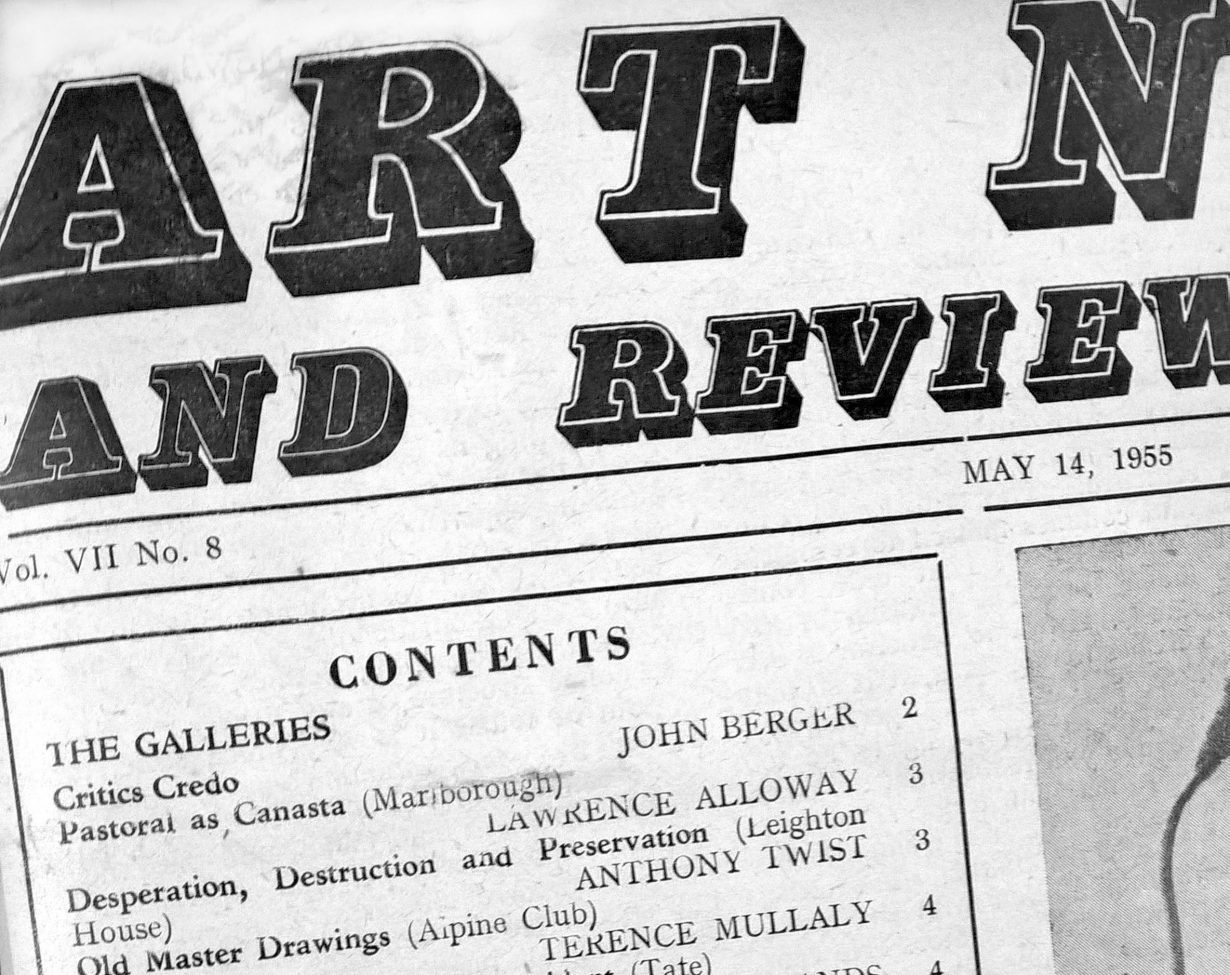During 1955, Art News and Review (as ArtReview was then called) published a series of opinion pieces – under the common title ‘Critics Creed’ – by art critics on how they understood the role of criticism. In his contribution (titled ‘Critics Credo’) Berger reflects on the nature of ‘public’ criticism, on the difference between interpretation and judgement, and on what makes criticism more than a merely subjective activity. More than sixty years on, Berger’s forthright position still resonates today.
Two quite different types of criticism are frequently confused: Studio criticism and Public criticism.
Studio criticism really amounts to a form of art-teaching (if painters will excuse the impertinence of that phrase) in which the critic is only concerned with advising the artist. It is – if one uses the word in its broadest sense – technical criticism. The critic accepts the artist’s aims and concerns himself to commenting upon his methods. “That blue comes forward too much”. “The drawing of that hand is first rate”. If Studio criticism is ever concerned with questioning aims, it is so only in direct relation to the artist’s personality. “Are you sure you’re not trying to be too intellectual?” “Do you realise that the effect of this is horrific rather than tragic?”
Public criticism, as the name implies, is addressed to the general public. The critic, instead of identifying himself with the artist, identifies himself with the spectator. He cannot consider the works in question as works in progress – a progress which his comments might influence; he must consider them as presented works and must try to evaluate them in relation to the world to which they have been presented.
If the distinction between these two forms of criticism was more generally recognised, artists who expect press criticism to be “understanding” would be spared much disappointment, and the public would be spared a great deal of (to them) boring and obscure writing which assumes that they are initiates of the studio.

The next important point to realise is that Studio criticism has always and will always exist. It can be given by amateurs, other painters, teachers, or anybody who is articulate enough and has sufficient technical knowledge and imagination. Public criticism on the other hand is a comparatively recent innovation, barely two hundred years old. Its very existence is a result of the separation of art from public life. If the function of the public critic is to relate works of art to ordinary life, it follows that either the works themselves are remote from that life as it is normally understood, or that the public are so confused by art that they cannot see the connections which do exist. Thus, the critic who is truly concerned – not with a few of his studio mates who happen to be painters – but with all the possibilities of art as a human activity, – works, like a doctor, to make his own job unnecessary. I believe that finally the art critic will be unnecessary. Writers and thinkers will always consider art as one of their subjects, but the exclusive art critic will become an anachronism.
Granted, however, our present situation, what should be the public critic’s method? He can of course avoid the problem altogether as Eric Newton did in his Credo. He can simply describe his own experience in front of a work of art in a prose “as precise, as vivid and as persuasive as he can make it” – and leave it at that. I am not suggesting that the critic shouldn’t describe his aesthetic experiences as well as he can – but that is the most elementary part of his job. The real problem is not how he should communicate his experience, but how he is to connect it with what is simultaneously happening in the world. I am often accused of dragging politics into art. But surely, it is criminally irresponsible for any intellectual today not to consider his and every subject in relation to the threat of the H bomb!
Yet apart from the H bomb (if such a phrase makes sense) there are other reasons why the problem of criticism is fundamentally the problem of connection. First, the critic, as I have already said, represents the spectator, and the majority of the average spectator’s pre-occupations are not aesthetic. Secondly, it is only on the perimeter of one’s thinking and feeling that it is possible to separate and label issues – Aesthetic, Moral, Social, Political, Sensuous, Spiritual, etc. Within the development of anyone’s total experience all these issues coalesce into a general attitude of human faith (or despair) of which art is one, but only one expression. Thirdly, if as I have already implied, art today suffers from its isolation, it is obviously the duty of the critic to try and break down that isolation by showing its connection – at the worst negative, and at the best positive – with our whole human experience and predicament. And lastly, as a Marxist, believe that there is a definite causal connection – though by no means an automatic one – between the art, religion, philosophy, ethics, policy, and economic structure of any society.

But of course it is very much easier to explain why one should connect, than how. One can list the critic’s minimum qualifications: that he should understand the processes or art, if possible by personal experience: that he should have looked at many works: that he should have a sense of history: that he should have a finger on the pulse of significant contemporary affairs: that he should make himself familiar with all the different divisions and levels of taste in our society: that he should know something about the way artists live and the conditions of their employment (or unemployment): that he should be at least equally concerned with those who challenge the fashions as with those who make them: that he should follow, if only as an amateur, the development of the other arts besides his own: and over and above all this, that he should have a passionate love for art, that he should never forget, however trivial certain situations in which he may find himself, that art is one of the noblest achievements of man.
But the question still remains, granted all these qualifications. How does he connect – which is to say assess, judge and interpret? if he is dealing with works of the past in relation to their historical setting, the problem is comparatively easy, for the facts, having been discovered, sorted out, and estimated in perspective, will suggest their own logical connections. When he is dealing with contemporary works or with works of the past, in relation to their significance for the present, I believe that he can only connect by making an imaginative leap. He must have the knowledge and experience which I have listed in order to sustain his imagination – but the final process is bound to be an imaginative one. And it is here that I disagree with most of my colleagues for I do not believe that the critic’s imaginative function lies in re-creating or simply interpreting the work, but in assessing its likely effect, however small, on the general development of life. He must not only look at it from his own personal point of view, but from that of the artist, other painters, the conscious and unconscious mind of the spectator, the general public and even, if possible, future generations. If he does this, he will have a chance of being able to assess its objective effect instead of its totally unimportant subjective effect on himself.
I only want to add that what I have written is a Credo. It is what I believe is necessary for sound and valuable criticism. It is not a description of what I think I personally achieve.
First published in Art News and Review, 14 May 1955
